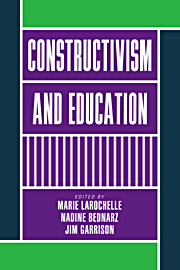Book contents
- Frontmatter
- Contents
- Preface
- List of contributors
- I Introduction
- II From epistemological constructivism to teaching: a variety of views
- 2 Why constructivism must be radical
- 3 An epistemology for didactics: speculations on situating a concept
- 4 Toward a pragmatic social constructivism
- III Teaching within the constructivist mode: practices and promises
- IV The mediating role of teachers and teacher education
- V Conclusion
- Notes
- References
- Index
3 - An epistemology for didactics: speculations on situating a concept
Published online by Cambridge University Press: 04 August 2010
- Frontmatter
- Contents
- Preface
- List of contributors
- I Introduction
- II From epistemological constructivism to teaching: a variety of views
- 2 Why constructivism must be radical
- 3 An epistemology for didactics: speculations on situating a concept
- 4 Toward a pragmatic social constructivism
- III Teaching within the constructivist mode: practices and promises
- IV The mediating role of teachers and teacher education
- V Conclusion
- Notes
- References
- Index
Summary
The relationship between constructivist epistemology and teaching is uneasy, as is often evidenced by the dissatisfaction or irritation which arises in discussions over didactics. This essay has been written with a dual objective in mind: The first consists in tentatively suggesting one possible explanation for the difficulties encountered in transposing constructivism into teaching practice, the second in proposing a number of speculations as to what might constitute a more relevant, if somewhat makeshift, type of epistemology for pursuing reflection on didactics.
At the outset, however, I wish to exclude from this debate the case of specialists who have seized on constructivism to advocate respectable didactic principles which are merely compatible with this current of thought and nothing more. Take, for example, their insistence on the necessity of students’ participation in the reconstruction of knowledge, a principle which has been applied in various ways from the days of the venerable Active School down to the present. It is not constructivism's duty to supply up-to-date arguments to pedagogical ideologies of even the most well-reasoned variety.
Subject, object, and knowledge
One traditional formula suggests that we consider knowledge as a particular relationship between a subject and an object; this way of viewing things lends itself well to interesting abstractions and worthwhile conceptual elaboration. But even before it was considered from the perspective of didactics, it was a source of ambiguities which the emergence of constructivism has not sufficed to clear up.
- Type
- Chapter
- Information
- Constructivism and Education , pp. 29 - 42Publisher: Cambridge University PressPrint publication year: 1998
- 1
- Cited by

